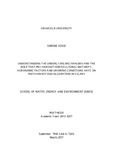JavaScript is disabled for your browser. Some features of this site may not work without it.
| dc.contributor.advisor | Terry, Leon A. | |
| dc.contributor.author | Rossi, Simone | |
| dc.date.accessioned | 2018-03-09T12:21:52Z | |
| dc.date.available | 2018-03-09T12:21:52Z | |
| dc.date.issued | 2017-03 | |
| dc.identifier.uri | http://dspace.lib.cranfield.ac.uk/handle/1826/13064 | |
| dc.description.abstract | Celery is a foliage crop which is commonly consumed for its fresh stalks, which are sold on the market in various retail formats. Celery is appreciated by consumers for its freshness, bright green colour, crisp texture, low calorific content and health promoting properties. An important problem affecting this crop after harvest is browning at cut ends, which is a physiological “disorder” manifesting with brown/black stains on cut or damaged surfaces. It manifests during handling and processing of vegetables, which is the phase where most of the postharvest damage occurs. Cut-end browning is believed to be due to the activity of two enzymes; polyphenol-oxidase (PPO) and phenylalanine ammonia-lyase (PAL). These two enzymes synergistically act to produce melanins, which are the pigments responsible for the black/brown appearance. This is a relevant economic issue as discoloured celery tends to be rejected by retailers, with negative implications for the growers and the UK fresh produce industry. Postharvest browning is not thought to be due to the activity of fungi or bacteria, yet the blackening of surfaces suggests to customers that the product is decaying. Research has been conducted to understand which postharvest factors can influence browning in celery. It has been shown that the use of controlled atmosphere (Gomez and Artes, 2004), heat shock treatments (Loaiza-Velarde et al., 2003) and postharvest application of high intensity light (Zhan et al., 2013) were effective in reducing incidence of the problem. On the other hand, research on pre-harvest factors is still scarce. The aim of the present work was to: 1-) investigate which agronomic factors can affect the severity of postharvest browning in celery; 2-) provide a better understanding of the underlying physiological and biochemical mechanisms involved in this “disorder”. Results showed that agronomic practices can affect postharvest browning in celery. Harvesting at late maturity stages and irrigating below the normal requirements increased postharvest discolouration in this crop. Additionally, the browning mechanism does not seem to be mediated by ethylene in celery. Further biochemical analysis on phenolic compounds and enzymatic activity (PPO and PAL) need to be performed to provide a better elucidation of the browning reaction in this crop. | en_UK |
| dc.language.iso | en | en_UK |
| dc.rights | © Cranfield University, 2015. All rights reserved. No part of this publication may be reproduced without the written permission of the copyright holder. | |
| dc.rights | CC0 1.0 Universal | * |
| dc.rights.uri | http://creativecommons.org/publicdomain/zero/1.0/ | * |
| dc.title | Understanding the underlying mechanisms and the role that pre-harvest horticultural maturity, agronomic factors and growing conditions have on postharvest discolouration in celery | en_UK |
| dc.type | Thesis | en_UK |
Files in this item
The following license files are associated with this item:

